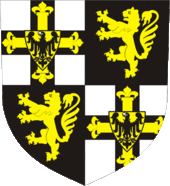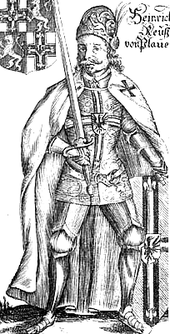Heinrich the Elder of Plauen
Heinrich the Elder of Plauen (* 1370 ; † 1429 in Lochstädt near Königsberg ), also known as the “Savior of the Teutonic Order ”, held the office of 27th Grand Master from 1410 to 1413. He came from the line of bailiffs and lords of Plauen older line , the Mühltroff family .
Life
Joined the order in 1391, from 1399 to 1402 he held the house commandery in Danzig ; then he was from 1402 to 1407 Commander of Nessau and from 1407 to 1410 Commander of Schwetz .
As the commander of the Pomeranian army corps of 2,000 men, Heinrich could no longer unite with the main army of the Teutonic Order in the summer of 1410 due to the sudden events. After the disaster of July 15, 1410 in the Battle of Tannenberg , he led his troops in forced marches to the Marienburg , where he prepared and strengthened the defense readiness until July 23, 1410 and collected the gradually arriving remains of the defeated army of the order.
In the following siege of Marienburg (July 26, 1410 to September 19, 1410) he successfully defended the Marienburg until the Polish-Lithuanian siege army, weakened by failures, hunger and epidemics and threatened by the advancing relief forces from Livonia and the Reich , on 19 September 1410 finally withdrew. In the weeks that followed, the order was restored in West Prussia.
On November 9, 1410, the General Chapter in Marienburg elected Heinrich von Plauen as Grand Master.
On February 1, 1411 he made peace with Poland in Thorn . The order did not have to cede any territories apart from Shamaites , but the high war indemnities and ransom for captured knights, a total of 100,000 shock Bohemian groschen , were serious. These forced Heinrich to raise taxes . He wanted to have these burdens carried by a regional council, to which 16 representatives of the cities and 32 members of the secular nobility should belong. In the following years Heinrich tried to fulfill the conditions of the peace treaty, in particular the reparation payments. This was made more difficult for him by disputes within the order, with the estates and by continued provocations on the part of Jagiellos .
Under Heinrich von Plauen, the order's internal crisis, which had been smoldering for a long time, broke out for the first time, accompanied by disputes with the increasingly self-assured estates. To put an end to Jagiello's intrigues, he decided to go to war in September 1413 - against the will of almost all rulers . The plan to carry out a surprise attack on Poland failed, as the Order Marshal Michael Küchmeister in particular thwarted the Grand Master's intentions and ordered the army to withdraw. Thereupon Heinrich von Plauen summoned the Prussian general chapter to Marienburg on October 14th, 1413 to have the marshal recalled. But he, well prepared, turned the tables with the help of the authorities, let the Grand Master fall through the chapter and arrest him and choose himself Grand Master.
Initially referred to the Castel Sant'Angelo as Commander , he was accused of high treason by his successor after his assumption of office, imprisoned and held in strict custody in Danzig and Brandenburg from 1414 to 1422 together with his brother, the Commander of Danzig. Only Küchmeister's successor, Paul von Rusdorf, freed him from custody and assigned him the office of caretaker von Lochstädt . Here he spent the rest of his life until his death in 1429.
tomb
Like his predecessors, Heinrich von Plauen was buried in the Annenkapelle of the Marienburg, where his grave slab can still be viewed. Heinrich von Plauen was originally buried in the St. Anne's Chapel of the Marienburg . In May 2007 archaeologists discovered Plauen's coffin in a crypt under the presbytery of the cathedral in Marienwerder (former West Prussia ). Together with his final resting place, the remains of two other Grand Masters were found, namely Werner von Orselen and Ludolf König von Wattzau . According to dendrochronological examinations of the wood used for the coffins as well as DNA analyzes of the bone fragments, it is "96% certain" that these are the people mentioned.
literature
Biographies
- Kurt Mühlhäuser: Heinrich von Plauen - Grand Master of the Teutonic Order . In: Home calendar for the Fichtelgebirge, Franconian Forest and Vogtland . Helmbrechts 2013, pp. 41–49.
- Erich Weise : Heinrich von Plauen. In: New German Biography (NDB). Volume 8, Duncker & Humblot, Berlin 1969, ISBN 3-428-00189-3 , p. 378 f. ( Digitized version ).
- Ferdinand Hahn: Heinrich von Plauen . In: Allgemeine Deutsche Biographie (ADB). Volume 11, Duncker & Humblot, Leipzig 1880, pp. 573-577.
- Carl Gerstenberg: Heinrich von Plauen. Grand Master of the Teutonic Order from 1410–1413. Inaugural dissertation. Hall 1873. ( digitized )
Family depictions
- Berthold Schmidt : The Reußen, genealogy of the entire Reuss house older and younger line, as well as the extinct Vogtslinien of Weida, Gera and Plauen and the Burgraves of Meißen from the House of Plauen . Schleiz 1903.
- Bertholdt Schmidt: History of the Reußenland , 2 volumes. Gera 1923 (1st volume) and 1927 (2nd volume).
Fiction
- Ernst Wichert : Heinrich von Plauen . Historical novel from the German East. Schild-Verlag, Munich 1959 (2 volumes, reprint of the edition of the German Book Association Berlin, 1881)
Web links
- Report on the discovery of Heinrich von Plauen's coffin in Spiegel.de
- Photos from the excavation work in 2007
- more photos from the excavation work in 2007
Individual evidence
- ↑ Hartmut Boockmann : The German Order. Twelve chapters from his story . CH Beck, Munich 1981. ISBN 3-406-08415-X . P. 179.
- ↑ "Listed according to 14 areas and 11 cities, 32 members of the so-called landed nobility and 16 townspeople [...] swore to serve the Grand Master [...] loyally." Hartmut Boockmann: Early history of corporate representations in Prussia . In the S. (Ed.): The beginnings of the corporate representations in Prussia and its neighboring countries . Munich 1992. p. 47.
- ↑ Agence France-Presse on December 11, 2008 ( Memento of January 3, 2013 in the web archive archive.today )
- ^ Ernst Wichert : Heinrich von Plauen in the Gutenberg-DE project
| personal data | |
|---|---|
| SURNAME | Heinrich the Elder of Plauen |
| BRIEF DESCRIPTION | Grand Master of the Teutonic Order |
| DATE OF BIRTH | 1370 |
| DATE OF DEATH | 1429 |
| Place of death | Lochstädt |




